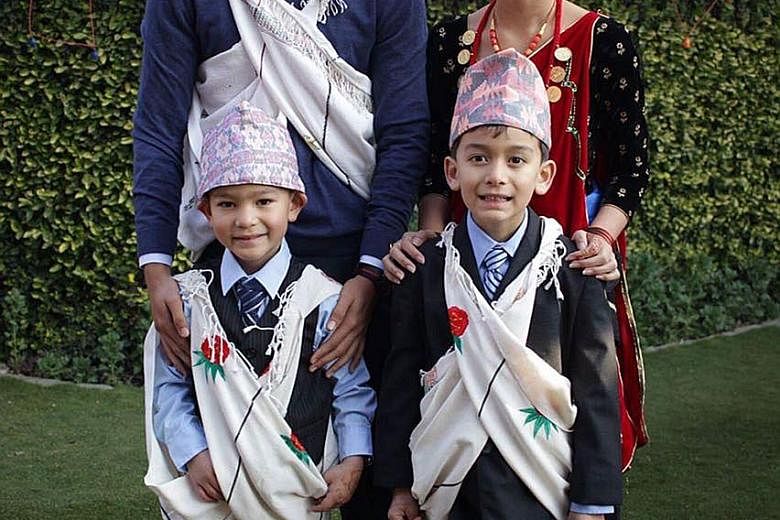They may be 3,600km away from their mountain home, but the 500 or so families that make up the Nepalese community in Singapore remain bound together by their shared customs and language.
In Singapore, many may naturally associate Nepal with the elite Gurkha forces that stand guard outside critical infrastructure and hunt down slippery criminals.
However, aside from the 2,000 Gurkhas and their families who live and train in Mount Vernon Camp, there is a small but thriving community of Nepalese in Singapore that has brought its culture and language over the seas to the island city.
Its members are involved in industries from software development and accounting to running restaurants.
Nepal is a land-locked country set in the Himalayan mountain range, most widely known as the home of Mount Everest and the birthplace of Buddha.
A diverse land with more than 100 separate ethnic groups, Nepal is a melting pot of cultures set between major powers China and India.
The Nepalese, despite their varied cultural and ethnic backgrounds, are united by their shared language, Nepali, the lingua franca of the country's 25 million inhabitants.
Most, like Mr Gary Bishwo Prakash Giri, the current president of the Nepalese Society, Singapore, came here to find a better life.

Mr Gary came to Singapore from Nepal in 1993 at the age of 24 to further his studies.
Now, the 47-year-old is the proud owner of the Shish Mahal restaurant in Albert Street, which he runs together with his 41-year-old wife, Mrs Subhadra Giri.
Despite having left his home country over two decades ago, he remains tied to its words, and the customs that come with them.
"In our language, we have this word 'jootho' for food or water that has been consumed by someone else," he said. "In Nepal, we would never take something that is 'jootho', unlike how we eat here."
Nepali is related to the Indian languages Hindi and Bengali (see other report).
"When people speak Hindi we are able to pick up about 10 per cent to 20 per cent of what they are saying. So we get the gist of it," said Mr Gary.
There is much shared vocabulary, and both languages are written using the same script - Devanagari.
-
Facts and figures
-
ORIGINS OF THE LANGUAGE
Nepali, historically known as Khas Kura, Parbate Bhasa or Gorkhali, was spoken by the Khas people, forerunners of several modern Nepalese ethnic groups such as the Chetri and the Bahun people.
A member of the Indo-European language family, Nepali has its roots in the ancient Sanskrit language and is hence related to the North Indian languages of Hindi and Bengali.
Although it is the lingua franca throughout Nepal, it is the first language of only 44.6 per cent of the population, reflecting the nation's ethnic and linguistic diversity.
The language is considered an official language in several Indian states.
NUMBER OF SPEAKERS
Excluding the 4,000 to 5,000 Nepali speakers housed in the Gurkha camp, there are around 1,000 to 2,000 Nepali speakers living in Singapore as citizens or residents.
WHERE TO LEARN IT
While there are no classes in Singapore, Nepali lessons can be accessed online at websites such as Cornell University's online language course, which can be accessed at http:// lrc.cornell.edu/nepali/online
NEPALESE-RUN BUSINESSES IN SINGAPORE
Himalayan Enterprise in Upper Aljunied Road is a provision shop run by Mr and Mrs Parajuli, both natives of Nepal.
Located within walking distance of Mount Vernon Camp, the shop stocks ingredients commonly used in Nepalese cooking such as dhall, Nepalese peppers known as "timmur", and "besaar", a Nepalese variety of the spice turmeric.
Shish Mahal is a Nepalese-run restaurant in Albert Street, serving authentic North Indian and Nepalese food. Tims Restaurant and Cafe, in Toa Payoh, serves Western and Nepalese food.
Ng Wei Kai
For example, namaste, which means "hello", is written the same way in both languages, though there is a slight difference in the pronunciation.
Nepal's geographical location has influenced not only its language, but its culture as well.
"In Nepal, it is not uncommon for somebody to be both Hindu and Buddhist. They do not contradict like they do here," said Mr Gary.
Members of the Nepalese Society meet every month.
They also gather to celebrate major Nepalese festivals like the Nepalese new year, which occurs in April, and Teej, a festival in August celebrated by the women.
Even though the community remains tight-knit, a lack of government support due to its small size means that many second-generation Nepalese born in Singapore have difficulty picking up the language.
"Even though my wife and I both speak Nepali to our children, with a lack of practice and nobody else to speak it to, they are not really fluent," said Mr Gary.
This is an even bigger problem for those who have married Singaporeans of other ethnicities.
Mr Tom Shrestha Niranjan Kumar, owner of a restaurant in Toa Payoh that serves Western and Nepali cuisine, said: "My wife is Singaporean Chinese. So it's difficult for my kids to pick up the language at all."
However, some Nepalese born here have made a concerted effort to become fluent in the language.
Outram Secondary School student Raul Gurung, 17, is one such person. A second-generation Singaporean of mixed Nepalese and Arab-Eurasian descent, Raul has not allowed the circumstances to stop him from acquiring the language.
"For me, it was about making sure that I could communicate back in Nepal and show them (his relatives) that even though it is harder for me to pick up the language, I am still fluent," he said.
Though Raul was born and raised in Singapore, he regularly returns to Nepal to visit his grandparents and other relatives.
To him, the language creates an instant bond among those who speak it, even though they are thousands of miles away from their home in the peaks.
"If you see someone on the street or in a restaurant, and you ask him, 'Ke tapain Nepali bolnuhunchha?' (Do you speak Nepali?), and he does, instantly you are brothers," he said.
"You make him feel at home here, and I really like that."



